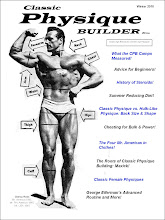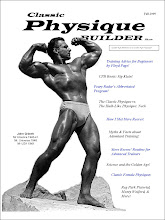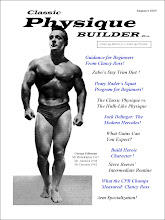
(Photo Above: Monty Wolford - Mr. Southwest 1949, Mr. Los Angeles 1951, Mr. Venice Beach 1951)
Perhaps the most destructive aspect of roid-based, mainstream bodybuilding today is its glorification of extreme, unnatural size! When some unfortunate person begins to accept the propaganda of the mainstream, roid-based magazines that Hulk-like physiques are something to admire and attain, then sooner or later this necessitates an acceptance of the associated, unhealthy, "drug/pharmaceutical culture" that makes such extremism possible.
Fortunately, in pre-roid Golden Age Classic Physique Building (of the 1940s and 50s), there was no glorification of extreme size! Instead, the goal was to attain an aesthetically-pleasing size and symmetry that was reminiscent of the beauty of the statues of the Ancient Greek and Roman gods! This necessitated an acceptance of a "culture of health and vitality" - which is why Reeves and the other champs of the pre-roid Golden Age (of the 1940s and 50s) were proud of their health and strength as well as their physiques! (Reeves would often say that his goal was to be the healthiest person alive!) What a difference in goals and cultures!
For classic physique builders of the Golden Age and today, this freedom from being obsessed with extreme size is liberating! Why? Because our size goals are realistic and attainable while pursuing health and vitality at the same time! Take a look at the photo above of the great Monty Wolford. This photo appeared in Fall 2009 issue of Classic Physique Builder (CPBzine). Who would not want a physique like his? It is healthy, full of vitality, with classic muscular size and symmetry! Is this kind of physique attainable and realistic? Let's look at his measurements:
Height: 5'8"
Weight: 168 lbs
Neck: 16"
Arms: 16"
Calves: 16"
Chest: 44"
Forearm: 12.5"
Waist: 28.5"
Thigh: 23.5"
Wrist: 6.6"
Monty did not need 18 inch arms like Reeves to look great. Why? Reeves was 6'1", Monty was 5 inches shorter. So to achieve a classic physique like Reeves, Monty's measurements needed to be smaller to match his height (and bone structure).
Neither Reeves or Wolford obssessed about extreme size. What for anyway? Do you want to look like a cartoon (i.e., "The Hulk") or would you rather look like a Greek god?! For modern classic physique builders (CPB'ers), the choice is not a hard one. Reeves and Wolford pursued classic size & symmetry, health and vitality! So do we!
So to achieve your classic physique, you need to follow a "culture of health and vitality" along with following pre-roid Golden Age methods of proper training, proper nutrition, proper rest, and persistence. Such a "culture of health and vitality" is not only good for the body, but it is good for your spirit and character and will set you apart and enable you to be a good example for others. In this way, classic physique building not only benefits you, but also will have a positive effect on those around you. What more could you ask for?
- CPB
P.S. For a free, 1 year subscription to Classic Physique Builder zine (CPBzine) - a pdf zine (do-it-yourself magazine) patterned after the muscle mags of the pre-roid Golden Age of Bodybuilding (of the 1940s and 50s), just email your name, the name of your city (not your actual address), state/province, and country to cpbzine@gmail.com. That's it! Any info you send us is strictly confidential. We don't share info with anyone. So you won't get on any unwanted lists or receive unwanted, unsolicited, automated email - even from us!







